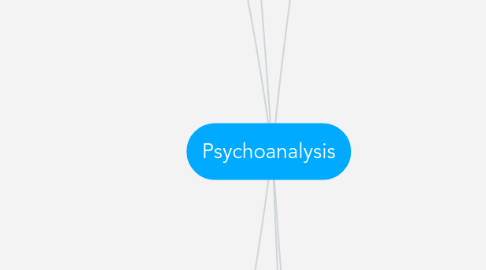
1. Ego Psychology
1.1. Neo-Freudian focusing on adaptive (conflict free) parts of ego
1.2. Emphasis on ego strength and its role in cooping with reality
1.2.1. Heinz Hartman
1.2.1.1. Conflict zone
1.2.1.1.1. Derived from ID
1.2.1.1.2. Conflicts and drives
1.2.1.2. Conflict-free zone
1.2.1.2.1. Secondary processes
1.2.1.2.2. Memory, perception and intelligence
1.2.1.2.3. Coping mechanisms
1.2.2. Anna Freud
1.2.2.1. Defence mechanisms used to deal with environment
1.2.2.1.1. Primitive
1.2.2.1.2. Advanced and developed
1.3. Accept ID and Superego but with less power
2. Carl Jung
2.1. 3 Structures
2.1.1. Ego
2.1.1.1. Personality which adapts to environment
2.1.2. Personal Unconscious
2.1.2.1. Subconscious and unconscious drives for the future
2.1.2.1.1. Unique experiences
2.1.3. Collective Unconscious
2.1.3.1. Archetypes- same experiences for all humans across the world
2.1.3.1.1. Self
2.1.3.1.2. Shadow
2.1.3.1.3. Anama/ Anamus
2.1.3.1.4. Persona
2.2. Libido (life energy)
2.2.1. Expression, creativity and fulfilling potential
2.2.2. Principle of Equivalence
2.2.2.1. Energy preservation between forms and focuses
2.2.3. Principle of Entrophy
2.2.3.1. Guiding principle of the mind with a goal to reduce tension of opposites
2.3. Dreams as compensation
3. Object- Relation Theories
3.1. Drive isn't directed to satisfaction of impulses
3.1.1. Drive is satisfied in relationships
3.1.1.1. How individuals relate to people around him
3.1.1.2. Early relationship as model to define later relationships
3.2. Melanie Klein
3.2.1. Biggest woman therapist to date
3.2.2. Schizo-paranoid position
3.2.2.1. Omnipotence of baby
3.2.2.1.1. Personal fantasies have real world effect
3.2.2.2. Desire for closeness and destruction of the good and bad object, respectively
3.2.2.2.1. Introjections
3.2.2.3. Paranoia that the bad object will kill me
3.2.2.3.1. Death and annihilation
3.2.2.4. Paranoia for destroying the good breast
3.2.2.4.1. Anxiety
3.2.3. Depressive position
3.2.3.1. 7 - 12 months
3.2.3.2. No omnipotence
3.2.3.2.1. Love and hate towards one object
3.2.3.3. 4 mental states
3.2.3.3.1. Know these four for the exam!
3.2.3.3.2. Jealousy
3.2.3.3.3. Greed
3.2.3.3.4. Envy
3.2.3.3.5. Gratitude
3.2.4. Projective identification
3.2.4.1. Opposite of projection
3.2.4.2. Feeling something due to interaction with other
3.2.5. Play therapy
3.2.5.1. Expression through play without need for verbalisation
3.3. Baby is born totally dependent
3.3.1. Interested in pre-oedipal stage
3.3.2. Mother viewed as baby ego
3.4. Winnicott
3.4.1. No age definitions
3.4.2. Aggression doesn't have a strong role in relationships
3.4.2.1. Drive for valuable relationships
3.4.2.2. Development of true self
3.4.2.2.1. Born with potential
3.4.2.2.2. Good enough mother
3.4.2.2.3. Crying and emotions
3.4.2.3. False self
3.4.2.3.1. Always being okay and showing no emotion
3.4.2.3.2. Disapproval in early life
3.4.2.3.3. Can be adaptive in different situations
3.4.3. Maternal Preoccupation
3.4.3.1. Stage where parent is focused on baby and not herself
3.4.4. Parental Child
3.4.4.1. Can effect future relations with people in authoritarian positions
4. Sigmund Freud
4.1. Topographic Theory
4.1.1. Conscious
4.1.2. Preconscious
4.1.3. Unconscious
4.1.3.1. Underlying reason for behavior, emotion and thought
4.1.3.1.1. Shown in EURKEA moment
4.1.3.2. Reviled through free association, dreams, slip ups and defences
4.1.3.2.1. Limitations
4.1.3.3. Modern view
4.1.3.3.1. We are more sensitive to certain stimuli
4.1.3.3.2. Adverts
4.1.3.3.3. TAT, Rorschach, Sentence Completion
4.1.3.4. Royal road to open unconscious
4.1.3.4.1. Dreams
4.1.3.5. Most of our information
4.2. Structural Theory
4.2.1. Id
4.2.1.1. Drive theory
4.2.1.1.1. Sexual or aggressive
4.2.1.1.2. Pleasure principle
4.2.1.1.3. Aniety
4.2.1.2. Primary throught
4.2.1.2.1. Thinking on the level of oneself
4.2.1.3. Energy (libido)
4.2.1.3.1. Pleasure is felt by release of energy
4.2.1.3.2. Libido - life and pleasure energy
4.2.1.3.3. Eros
4.2.1.3.4. Thanatos
4.2.1.4. Remains in unconscious
4.2.2. Ego
4.2.2.1. Executive functioning
4.2.2.2. Fear of punishment
4.2.2.2.1. Reality principle
4.2.2.3. Defence mechanisms
4.2.2.3.1. Primitive
4.2.2.3.2. Higher order
4.2.2.4. Secondary thought
4.2.2.4.1. Reason, judgement and memory
4.2.3. Superego
4.2.3.1. Moral values
4.2.3.2. Pathologies
4.2.3.2.1. Shame and guilt
4.2.3.2.2. Depression
4.2.3.2.3. Inferiority complex
4.2.3.2.4. Narcissism
4.2.3.3. 2 systems
4.2.3.3.1. Conscience
4.2.3.3.2. Ideal/ Ego ideal
4.3. Developmental Theory
4.3.1. Psychosexual stages
4.3.1.1. Energy focused on different erogenous zones
4.3.1.2. Oral (0-2)
4.3.1.2.1. Trust, acceptance and dependence
4.3.1.2.2. Aggressive and dominating
4.3.1.2.3. Erogenous zone: mouth
4.3.1.3. Anal (2-3)
4.3.1.3.1. OCD, held back, obsessions
4.3.1.3.2. Untidy, generous
4.3.1.3.3. Erogenous zone: anus
4.3.1.4. Phallic (3-7)
4.3.1.4.1. Vanity
4.3.1.4.2. Inferiority, envy
4.3.1.4.3. Oedipus
4.3.1.4.4. Electra
4.3.1.4.5. Erogenous zone: sexual organs
4.3.1.5. Latency (7-11)
4.3.1.5.1. Quiet sexual stage
4.3.1.5.2. Energy used in non-sexual relationships
4.3.1.6. Genital (11+)
4.3.1.6.1. Success in shared pleasures and dealing with the opposite sex
4.3.1.7. Fixation
4.3.1.7.1. Being stuck in an area due to unsatisfied drive
4.3.1.8. Regression
4.3.1.8.1. Stress can cause us to move back in stages
5. Alfred Adler
5.1. Less focus on sex but recognition of social urges and needs
5.2. Individual Psychology
5.2.1. Holistic Approach
5.2.1.1. The person as a whole and not the sum of parts
5.2.2. Constructivist Approach
5.2.2.1. We build our own perception of reality
5.2.3. Teleological Approach
5.2.3.1. Continuous growth due to different motivations over time
5.2.4. Energetic Model
5.2.4.1. Drive of superiority
5.2.4.1.1. Inferiority leads to growth
5.2.4.1.2. Drive of wholeness
5.2.4.1.3. Superiority complex
5.2.4.1.4. Inferiority complex
5.2.5. Social Urges
5.2.5.1. Desire to cooperate, depend on and help those around us
5.2.5.2. Effect of birth order
5.2.5.2.1. Sibling rivalry
5.2.6. Fictional Finalism
5.2.6.1. The subjective truth based on final goal
5.2.6.1.1. Work with self-talk in therapy
5.2.6.1.2. Self - narrative
5.3. Change of therapeutic setting to individuals opposite eachother
5.4. Parenting
5.4.1. Healthy development
5.4.1.1. Good self narrative
5.4.2. Unheathy development
5.4.2.1. No sensitivity to inferiority
5.4.2.2. Partent spoils the child by making him feel absent of inferiority
5.4.2.2.1. Over compensation
5.4.2.2.2. Surrendering to inferiority
6. Dreams
6.1. Freud
6.1.1. Condensation
6.1.1.1. Repressed returning ideas in hidden and condensed ways
6.1.1.1.1. Latent content
6.2. Jung
6.2.1. Compensation
6.2.1.1. An attempt to counterbalance an excessive conscious psychological tendency
6.2.2. Amplification
6.2.2.1. Symbols from the collective unconscious showing themselves through dreams
6.2.3. Dream teaches about future and doesn’t look at repressed memories

